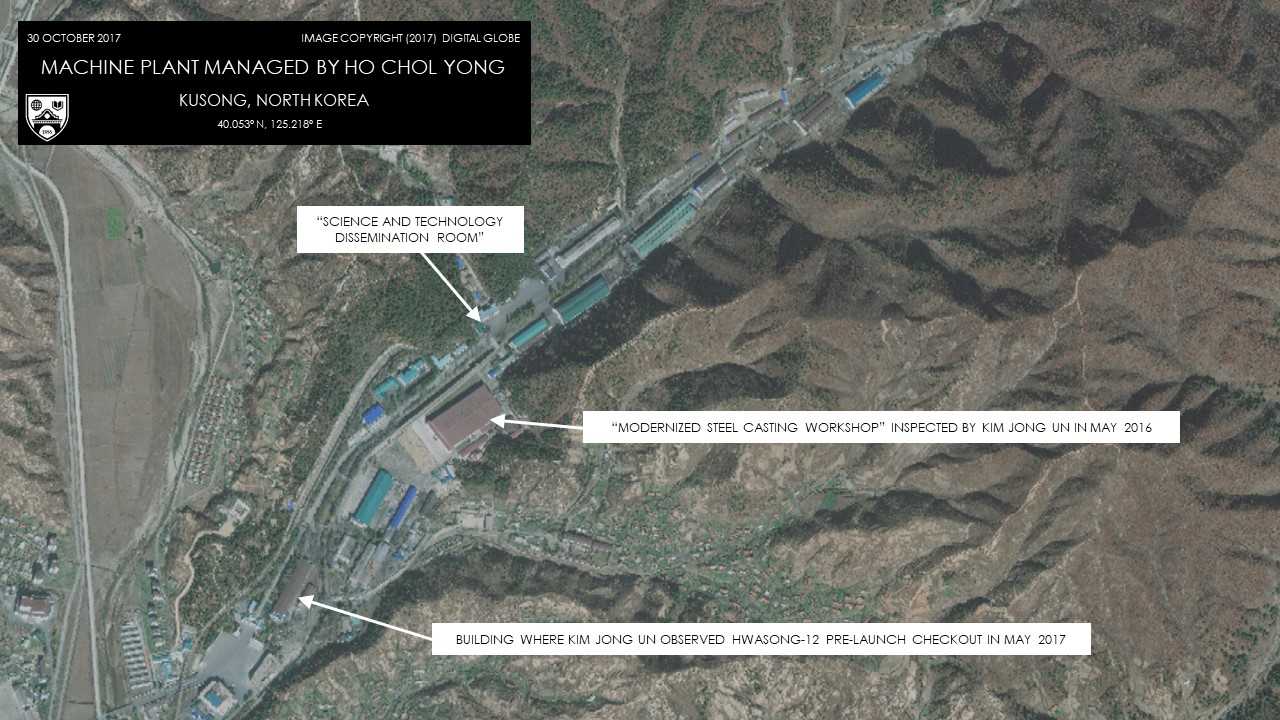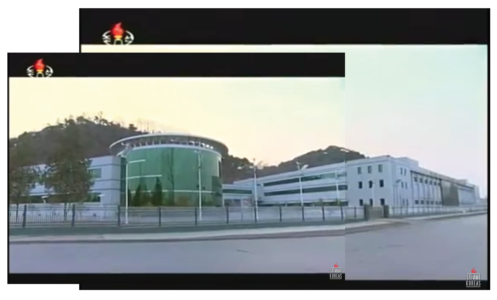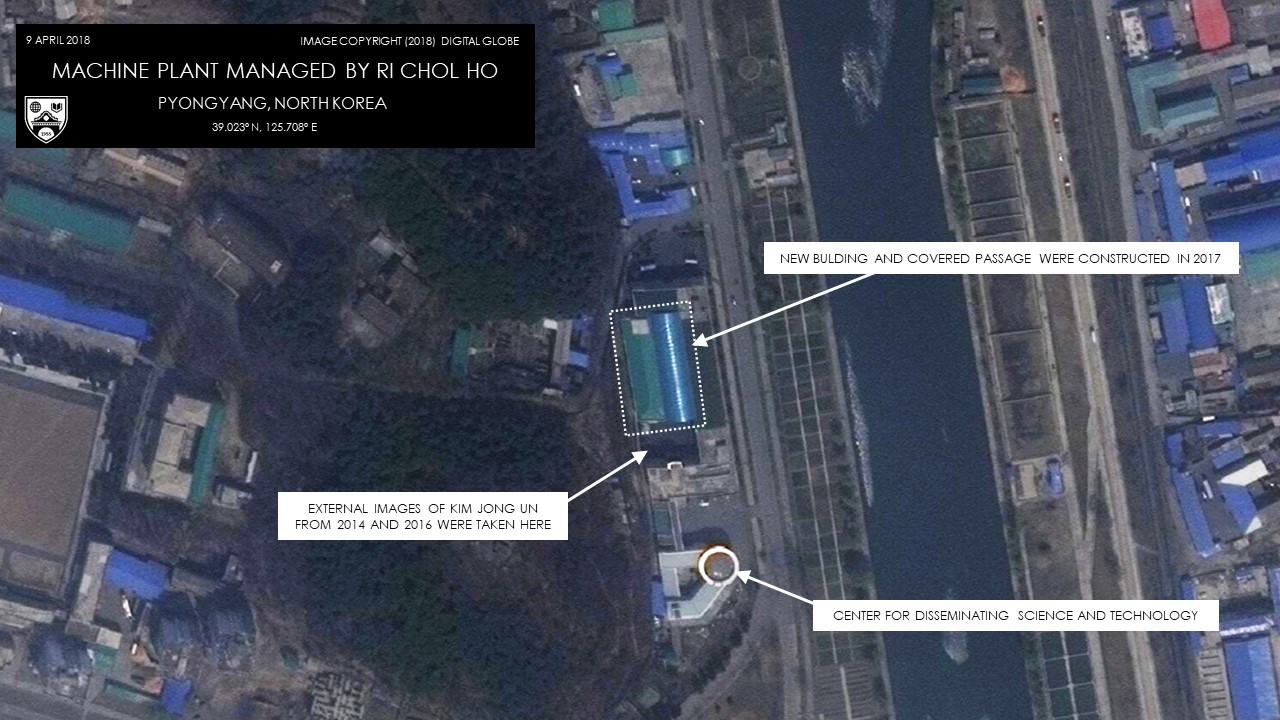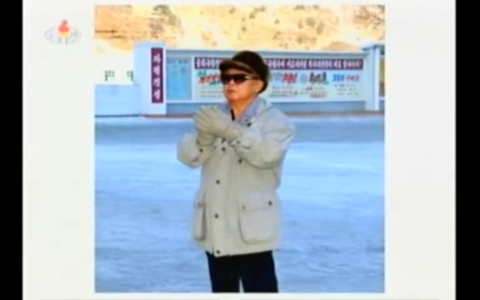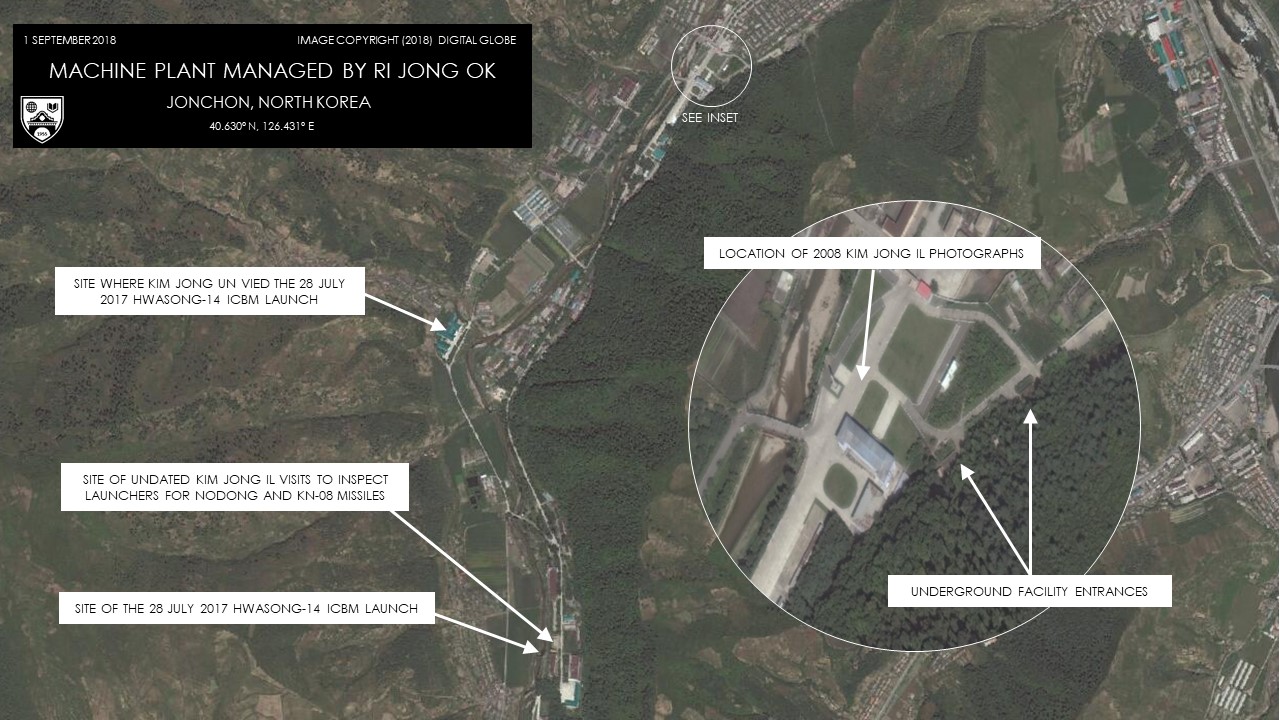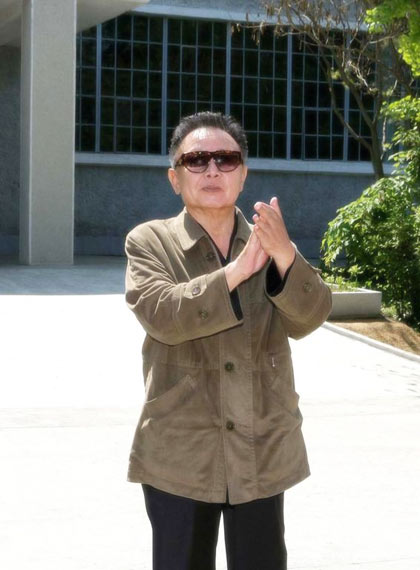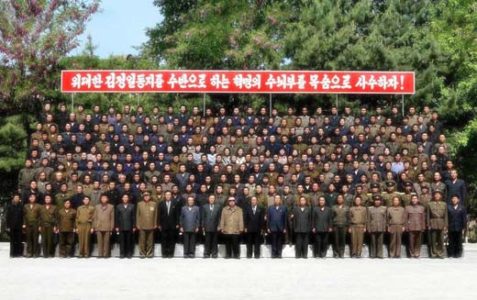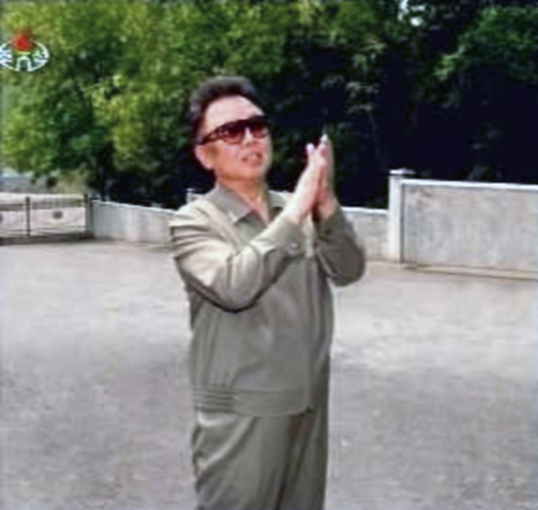January 17, 2019
Jeffrey Lewis and Dave Schmerler
Generally, the Korean Central News Agency (KCNA) and other North Korean media outlets identify the locations where Kim Jong Un (and, before him, Kim Jong Il and Kim Il Sung) conduct inspections and provide “on the spot” guidance. These visits are a routine way to signal the regime’s interests and priorities; to show off its achievements; and to highlight the crucial, irreplaceable role of the leader in all of the nation’s affairs.
In some cases, however, certain sensitivities dictate that leadership visits be handled discreetly. The media may not report on each and every stop on a guidance tour. In some cases, they may report on a visit without disclosing the name or location of the site. And in at least twelve cases involving visits to industrial facilities, the media has used a half-measure, identifying the site only by the name of its manager. For example, in 2016, Kim Jong Un visited a machine plant “managed by Ho Chol Yong.”
Tracking leadership visits is an important task for open-source analysis. We sought to locate these plants and determine whether they were previously known under some other name. We hoped to learn something about the regime’s motivations or find clues about future developments in North Korea, especially concerning nuclear and missile capabilities, which are often treated as sensitive matters.
We have now geolocated all of these sites. The twelve visits involved six different locations. Five were previously known by other names. A sixth site is a previously unidentified plant in Pyongyang that makes integrated circuits. All of these sites are believed to be linked to the missile program in one way or another.
What follows is a description of these sites, followed by observations about why North Korea may have chosen to obscure their locations and identities. A summary table appears at the end of the post.
1. Machine Plant Managed by Ho Chol Yong
Since January 2012, Kim Jong Un has made five publicized visits to a plant under this name. In declassified documents, the United States intelligence community has called this place the Kusong Tank Plant PUG. (PUG means partially underground.)
- “Kim Jong Un Inspects Machine Plant,” KCNA, May 18, 2016
- “Kim Jong Un Gives Field Guidance to Machine Plant Managed by Ho Chol Yong,” KCNA, May 27, 2014
- “Kim Jong Un Gives Field Guidance to Machine Plant Managed by Ho Chol Yong,” KCNA, June 16, 2013
- “Kim Jong Un Visits Factories to Congratulate Workers on May Day,” KCNA, May 1, 2012
- “Kim Jong Un Provides Field Guidance to Machine Plant,” KCNA, January 22, 2012.
The plant makes tracked vehicles such as tanks. Kim Jong Un’s visits corresponded with a significant expansion of the plant, including a large new factory building, and construction of a nearby vehicle proving ground.
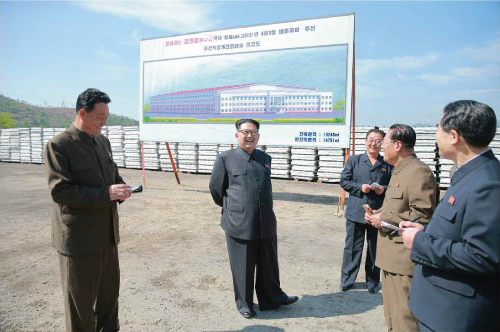
Kim poses at the construction site of a ‘modernized steel casting workshop.” (Image from Rodong Sinum showing Kim Jong Un’s May 2016 visit.)
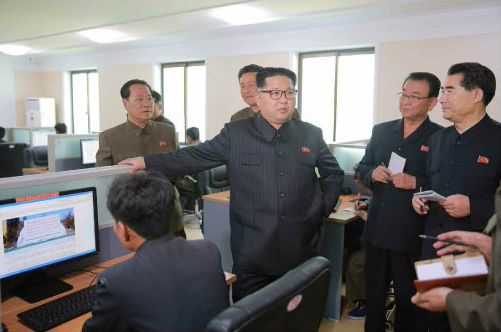
Kim visits the “room for disseminating science and technology.” (Image from Rodong Sinum showing Kim Jong Un’s May 2016 visit.)
In retrospect, this expansion was probably connected to the development of new classes of tracked launch vehicles for missiles such as the Scud short-range ballistic missile, Pukguksong-2 medium-range ballistic missile, and Kumsong-3 coastal defense cruise missile. A vehicle proving ground was constructed 4.5 km away. The proving ground previously hosted an ejection test stand and was the site of a flight-test of the Pukguksong-2 in February 2017. North Korea may have sought to obscure the location of Kim Jong Un’s visits in order to avoid drawing attention to the factory’s apparent role in the production of missile launch vehicles.
North Korea also selected this site for Kim Jong Un to observe missile checkout activities prior to the May 14, 2017 Hwasong-12 intermediate-range ballistic missile test. This is a common theme for this class of sites: Three of the six were later chosen for important missile tests overseen by Kim Jong Un.
2. Machine Plant Managed by Jon Tong Ryol
In declassified documents, the United States intelligence community has called this site the Panghyon Nodongjagu Fabrication and Assembly Plant. It manufactures light aircraft, but it may also be involved in the production of missiles.
- “Kim Jong Un Visits Machine Plant,” KCNA, April 1, 2015
- “Kim Jong Un Gives Field Guidance to Machine Plant,” KCNA, August 10, 2014
Panghyon has long been suspected of hosting missile-related activities. As in the case of three other plants, Kim Jong Un later observed a missile test here: the July 4, 2017 launch of the Hwasong-14 intercontinental ballistic missile (ICBM). It seems likely that this site is involved in missile production as well as aircraft production, and that the additional security around Kim’s visit reflected efforts to obscure that fact.
3. Machine Plant Managed by Ri Chol Ho
(aka Machine Plant Managed by Kang Thae Ho)
This is the only site that is not known to have been visited under some other name. It is a previously unidentified plant located in Pyongyang for producing integrated circuits, which are crucial for space and missile applications.
- Kim Jong Un Gives Field Guidance to Machine Plant, KCNA, April 8, 2016
- Kim Jong Un Provides Field Guidance to Machine Plant, KCNA, March 20, 2014
- Kim Jong Un Inspects Newly Built Machine Plant, KCNA, May 14, 2013
KCNA provided no location information beyond noting that Kim described it as “a nice plant in a park” and that it was newly constructed in 2013.
The site turns out to be close to one of North Koreas other locations for producing integrated circuits, the Pyongyang Integrated Circuit Factory. North Korea may well have chosen to obscure the location of this site due to concerns that a factory producing integrated circuits would be a target for cyberattacks. In 2015, Reuters reported that the United States had attempted to target North Korean facilities with computer viruses. In 2017, the New York Times reported that President Obama “had ordered Pentagon officials to step up their cyber and electronic strikes against North Koreas missile program in hopes of sabotaging test launches in their opening seconds.” Even if they cannot confirm these reports, North Korean officials are likely to be concerned about the possibility of such attacks.
4. Machine Plant Managed by Ri Jong Ok
This site is associated with the manufacture of missile launchers. In declassified documents, the United States intelligence community has called it the Mupyong-ni Arms Plant PUG. (This place may have previously been identified as the Chonchon-Up Munitions Factory PUG 65.)
KCNA identified the location of the plant only as being in Jagang Province.
This same site had previously been identified by CNS researchers using 14 seconds of interior video of a launcher assembly building. This is the third plant on this list that was later the site of a missile launch attended by Kim Jong Un. On July 28, 2017, Kim Jong Un observed the second launch of the Hwasong-14 ICBM from this location.
North Korea has shown at least three visits to this site in state media without ever identifying the factory directly.
5. Machine Plant Managed by O Mun Hyon (2010)
This plant makes computer numerical control (CNC) machine tools and is probably affiliated with the Kusong Machine Tool Plant, located a few km away. The Kusong Machine Tool Plant is also where researchers have observed what appears to be an indigenously produced flow-forming machine prototype: a tool with important uses in manufacturing rocket motor casings and gas centrifuge rotors.
A recent article at the DailyNK website reported that the director of the Kusong Machine Tool Plant was fired by Kim Jong Un in November. “Kim Jong Un recently made an on-the-spot visit to the Kusong Machine Tool Factory in North Pyongan Provinces Kusong City,” DailyNK reported on November 29. The director of the enterprise was stripped of his Party credentials and fired from his position a day later, (and) demoted to the position of a common logger at the Rimsan Enterprise in Rimsan County, Jagang Province. If true, that’s bad news for O Mun Hyon, or one of his successors.
The Kusong Machine Tool Plant probably has two campuses: the main Kusong Machine Tool Plant, which was built with Hungarian assistance in the 1950s, and a partially underground plant that Kim Jong Un visited in 2010. Defense enterprises in North Korea often have subordinate enterprises, especially when the primary enterprise is largely above ground.
6. Machine Plant Managed by Jong Il Man
This site was previously identified in the North Korean media as the Sinhung Machine Plant. It may be associated with the final assembly of missile launchers. In declassified documents, the United States intelligence community has called it it the Sinhung Armored Vehicle Assembly/Repair Plant. Previous analysis suggests that components built at Mupyong-ni (“Machine Plant Managed by Ri Jong Ok”) were shipped to Sinhung for final assembly.
Although the Sinhung Machine Plant has above-ground workshops, as in the case of the Mupyong-ni Arms Plant and the Kusong Machine Tool Factory, it appears that a substantial amount of work there occurs underground.
Conclusion
North Korea tried to disguise the locations of twelve visits to six different sites over the course of a decade. We found each of them.
It’s not clear why North Korea disguised these visits. Some of the plants, like the factories that make integrated circuits or CNC machine tools, would be plausible targets for a STUXNET-like attack. North Korea may be reluctant to share those locations precisely to make them harder to target.
In other cases, however, the visits may have been related to the development of new missile-related systems that North Korea was not yet prepared to reveal. In the past, we have observed that visits to certain ostensibly civilian factories also have had military aspects that would be disclosed later. In retrospect, the visits to the Machine Plant Managed by Ho Chol Yong were probably related to the development of tracked launch vehicles for some of North Korea’s ballistic and cruise missiles.
In particular, the large number of sites on this list (3) associated with the production of missile launchers the Kusong Tank Factory, the plant at Mupyong-ni, and the Sinhung Machine Plant suggest that North Korea is focused on the domestic production of these systems. (Another site that North Korea has identified by name is the March 16 automotive plant in Pyongsong that is linked to the development of Hwasong-15 ICBM launch vehicles.) Kim Jong Un’s close attention to these sites appears to reflect his commitment to reducing the DPRK’s dependence on imported chassis for the Strategic Force.

